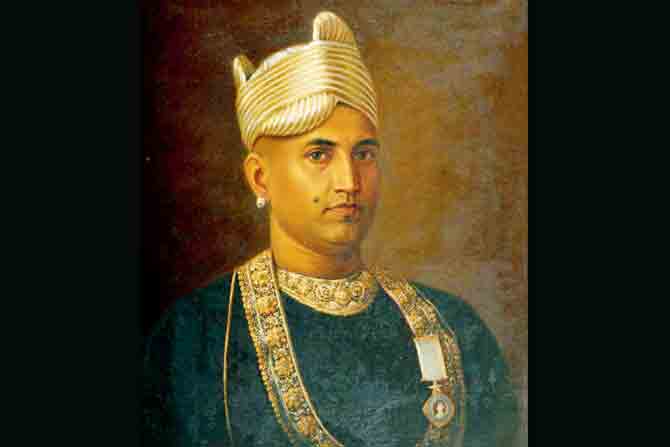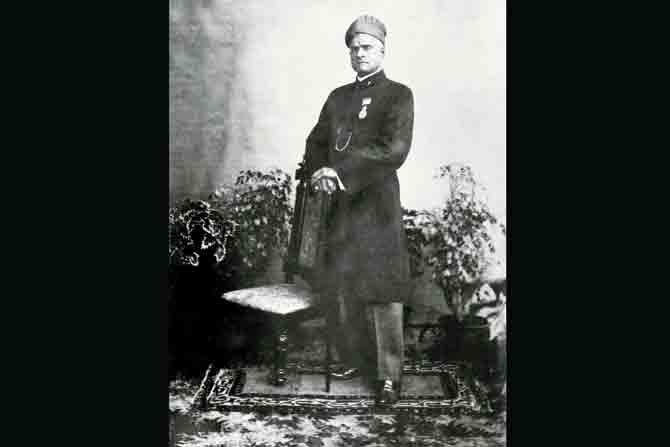Historian Manu S Pillai-s "long relationship" with the work of legendary master painter from Travancore, Raja Ravi Varma, has translated into an illustrated book that delves into his portrait-making enterprise

Rani Janaki Subbamma Bai Sahib, The Rani of Pudukkottai who viewed Sir Seshiah Sastris innovations in that state as prejudicial to the power of the royal house and its traditional networks of support and patronage. Pics courtesy/ The Raja Ravi Varma Herit
Inspiration is like a muse—it opens the floodgates of creativity, and opportunity. Manu S Pillai-s first historical tome, The Ivory Throne: Chronicles of the House of Travancore 2016, may have been populated with the stories of many a maharaja and maharani, but the Sahitya Akademi Award-winning writer found a stimulus in Raja Ravi Varma, the legendary master painter, who was a close member of Travancore royals and whose granddaughters had been adopted by the family. Varma, he shares, was a recurring figure during his research. "When I interviewed different members of the Travancore royal family, I often saw original canvases of his on their walls," Pillai recalls. It was only fitting then, that he opened that book with Varma-s story. That, however, was just the beginning of Pillai-s "long relationship with Varma-s work".
His new book, The World of Raja Ravi Varma: Princes and Patrons, a visual archive that will have an online release on April 29, puts the painter and his portraits at the centre of his research. The coffee table book will comprise several dozens of portraits ascribed to Varma, including some rare, previously unseen and relatively obscure ones from his family circles. In a first, Pillai will also be examining Varma-s impetus for painting these diverse groups of people.
ADVERTISEMENT

Kerala Varma Valiya Koil Tampuran 1845-1914, in this portrait ascribed to Ravi Varma, from the mid 1890s
The book was born out of a conversation between Pillai and Gitanjali Maini, managing trustee & CEO of The Raja Ravi Varma Heritage Foundation, Bengaluru, early last year. "It struck us that while Ravi Varma-s initial fame grew out of a successful portrait-making enterprise, these paintings [unlike his Puranic paintings that have been richly investigated and even interrogated] had not been studied as an archive of history in their own right. The idea of using his portraits to tell the stories of the men and women who appear in them, seemed like a novel and interesting proposition," says Maini, who got Pillai aboard the project.
It might seem surprising that Varma-s portraits have never been nuancedly read before. They were easier to miss, because they have often been looked at as simple depictions of people-s faces and forms, says Pillai. "But the time and context in which Ravi Varma worked is what makes these portraits special. When a maharajah sits for a portrait, he is aiming to create an idealised image of himself, one that transcends the ordinary. Often, he may want to communicate, in pose and gaze, certain messages. So too, with bureaucrats. These were men who began as clerks in the colonial service, hoping they would have R20 salaries; but with time they rose to places of importance, carved out spaces for Indians to access power despite the unequal nature of the British system, and appeared in portraits that show them as the new elite of India—men who had western education, but were still rooted in Indian ideals. Before more aggressive nationalism came into play, these -moderates- were the chief voice for Indian aspirations. They belied British claims that Indians were unable to rule themselves." For Pillai, this historical angle was fascinating. There was also the social and cultural aspect to his work.

Manu S Pillai
The portraits, especially those of women, provide a visual history of the evolving ideas in Indian society on gender, race and caste. "Ravi Varma lived in a time when Victorian influences on Indian minds was very high. His own granddaughters, who I cover in my first book reflect this: they were products of a matrilineal system, but under increasing patriarchal pressure, with the result that one of them ended up abolishing the very matrilineal order that brought her to power. Even in Ravi Varma-s lifetime, you see that a new ideal of womanhood came into play—this is most visible in the portrait of his mother-in-law a forbidding, imperious lady who looks the part in the painting as opposed to the one he did years later of his daughter, who was equally imperious, but whose features were softened and made more gentle to appeal to a changing audience."

A 1904 studio photograph of Raja Ravi Varma after receiving the Kaiser-e-Hind Medal from Lord Curzon, then Viceroy of India
Since this is an illustrated book, Pillai says that he has deliberately not written it in a "dense way, even though it touches on the necessary academic aspects of the subject". Apart from portraits, the book also has a large collection of photographs.
While researching for the book, Pillai, who is as gifted a storyteller, as he is a historian, also chanced upon interesting vignettes associated with the painter-s life. "I discovered, for instance, something that had evaded all biographers of the artist so far—the involvement of his [Varma] father-in-law in a sordid crime in the 1860s, which captured the attention even of the British press," says Pillai. Rukmini Varma, the great-great granddaughter of the master painter and the chairperson of the foundation, shared information on how some of Varma-s Puranic paintings are also, portraits of sorts. "One of Rukmini Varma-s great-uncles, for example, was the man who appears in Sri Rama Vanquishing the Sea 1906," he shares. Rukmini also gave Pillai a lead on the family of Varma-s missing eldest son, who was addicted to alcohol and disappeared in 1912. "I managed to find the name of his wife and daughter, and the fate of his family in Kerala. So too, while we should not succumb to mythologising him, there is a store of anecdotal information passed down among his descendants."

Gitanjali Maini
This book, says Maini, will be available on the foundation-s digital archive. "[To access it], one needs to simply reach out to the foundation with an enquiry and we will take it forward," she says, adding, "We made the book with the specific intention of building a resource for the foundation. There is also a larger perspective behind having commissioned this project—we wanted to showcase that period of India 1848 to 1906 as visualised through the eyes of Ravi Varma. Hence, we would like to keep the content exclusive, but make the knowledge available to all."
To contact the foundation, visit: www.therrvh foundation.com
Catch up on all the latest Mumbai news, crime news, current affairs, and a complete guide from food to things to do and events across Mumbai. Also download the new mid-day Android and iOS apps to get latest updates.
Mid-Day is now on Telegram. Click here to join our channel @middayinfomedialtd and stay updated with the latest news
 Subscribe today by clicking the link and stay updated with the latest news!" Click here!
Subscribe today by clicking the link and stay updated with the latest news!" Click here!







